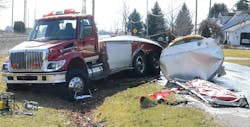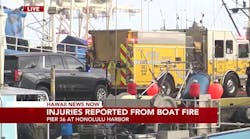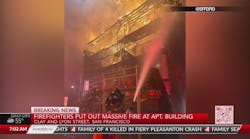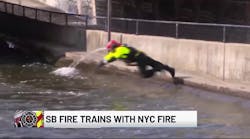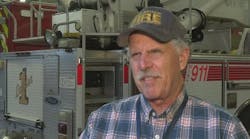I was looking at my website, emergencyvehicleresponse.com, and on the home page alone, there were 12 stories, all of which involved apparatus accidents. Eight of the 12 stories involved apparatus rollover, and seven of those involved tankers/tenders. Interesting fact: Tankers/tenders make up only 3 percent of the United States’ firefighting fleet, yet on any given year, they make up a majority of serious apparatus accidents.
What do most, if not all, of these tanker/tender accidents have in common? There are several factors worth review.
Limited experience operators
Tanker/tenders involved in accidents are typically driven by volunteer firefighter operators with a limited amount of experience. Many are driven by young firefighters, 20–30 years old, who have no experience operating heavy trucks. The tankers/tenders are being driven with little or no training.
Dangerous environments
These vehicles are usually driven on rural roads that are 1½-half lanes wide with drainage ditches, gullies on either side, ready to suck your apparatus into them. The roads are twisty, turny and hilly, not to mention more crowded than they have ever been due to more people moving into rural environments.
Apparatus advancements
Tankers/tenders, pumper tankers, engine tankers, pumpers or engines with large booster tanks—these apparatus all have one thing in common: They are carrying large amounts of water. The apparatus are bigger, higher, longer, heavier, faster and easier to drive than their predecessors.
The game-changer was definitely automatic transmissions. Why were automatic transmissions a good idea? Because anybody could drive them. Why were automatic transmissions a bad idea? Because anybody could drive them. Clearly not everyone is capable of driving, operating and controlling a 30-ton fire truck.
The apparatus manufacturers have actually done too good of a job, if that is possible. Through innovation and technology, we have single-axle trucks that are now capable of carrying 59,000 pounds and tandem-axle vehicles that can carry 84,000 pounds. These trucks generally drive better, handle better and are quieter than the private vehicles that the operator would normally drive. This results in a false sense of security for the operator, as they have failed to make the mental transition from their 2,000-pound private car to a 60,000-pound fire truck.
Older/retrofitted apparatus
The apparatus manufactures have simply outpaced the fire service’s ability to properly train operators to drive these big, heavy trucks. And while this relates to newer NFPA 1901-compliant tankers/tenders, not every fire department is fortunate enough to have newer apparatus. Instead they are using milk tankers, military refuelers, military surplus deuce and a halves, or homemade locally fabricated tankers/tenders.
These water-haulers were simply not designed or engineered to haul water. Most are not properly baffled, if they have baffles at all. This group of water-haulers represents a clear and ever-present danger. I wish you could walk in my shoes and see what I get to see. Many firefighters may think that these apparatus do not exist anymore, and that is simply not true. We did a fleet evaluation last month in Massachusetts and found a 1978, overweight, Dodge chassis, military refueler in service as the first-out tanker.
Seatbelt use
The final commonality is that most of the operators are NOT wearing seatbelts and are ejected or partially ejected and crushed by their own fire truck. It is critical that operators always wear seatbelts in any type of apparatus.
Putting it all together
Combining the factors above, we see that most incidents are similar in nature. We often have a young driver with limited experience. The driver has failed to make the mental transition from his or her private vehicle to the fire apparatus that they are now operating.
The operator turns on the lights and sirens and moves the apparatus onto the road. The roads are full of hills, turns and ditches, and they are more crowded than they have ever been and are not very wide.
The operator gets excited and starts driving too fast for the size and weight of the apparatus and the condition of the roads. The apparatus comes to a turn in the road, and the driver loses control. (That is the politically correct term for going too damn fast!) Many of these rural roads have no shoulders, so the operator gets the vehicle off the roadway into the loose stuff. The loose stuff is that section of the road between the blacktop (if there is one) and the ditch. The operator panics and overcorrects.
At this point, the apparatus may start to roll over or the apparatus is now headed to the other side of the road where the operator again tries to correct but overcorrects. At some point, the vehicle, based on the laws of physics, will start to roll over. Remember, if you are driving a 3,000-gallon tanker/tender and yank on the steering wheel in a panic, you are changing the trajectory of more than 24,000 pounds of water weight in motion. Depending on the water carried, the weight of the vehicle and the speed the apparatus, these can be very violent, often fatal, events, particularly if the operator is not wearing a seatbelt.
Train, train, train
So what is the quick fix? There isn’t one. But with time and perseverance, you can make important changes to reduce the likelihood of a tanker/tender accident. And it starts with training. We need to train, train, train and train some more. There is no magic bullet or quick fix, but training is critical in avoiding these tragic incidents in the future.
If you are in a tanker/tender and you have lost control, what can you do to regain control? Most experts will tell you to NOT panic. Perhaps easier said than done. Do not yank the steering wheel, and do not slam on the brakes. Rather, hold onto the steering wheel and let the automatic transmission, if so equipped, slowly decelerate the vehicle (or down-shift a manual transmission). The auxiliary brake will work in tandem with the transmission to slowly decelerate the vehicle as well. Obviously, this will only work if you have a clear path ahead.
Another loss
As I am working on this article, I learned of a line-of-duty death involving a tanker in Oklahoma. Michael Dale Russell, a firefighter with the Leach Fire Department, died in a single-vehicle crash while en route to a structure fire, according to the Oklahoma Highway Patrol (OHP). Troopers say Russell, 68, suffered massive injuries and was pronounced dead at the scene.
The crash occurred on Feb. 22, at about 7:30 a.m., southwest of Leach on County Road S510 in Delaware County. Russell was traveling southbound in a 2003 tanker truck when he ran off the right side of the road, overcorrected, and the truck overturned 1½ times, coming to rest on its top, the OHP report states. Russell was ejected out the driver’s side window and was pinned under the truck for two hours. Troopers say he was not wearing a seatbelt. OHP is still investigating the cause of the crash, but the report noted that it was foggy at the time of the incident.
Our thoughts and prayers go out to the Leach Fire Department and the family and friends of Driver/Operator Russell.
Final thought
If we do not learn from history, history is doomed to repeat itself! For more information, please review the U.S. Fire Administration document, Safe Operation of Fire Tankers: usfa.fema.gov/downloads/pdf/publications/fa-248.pdf.
